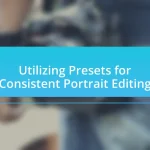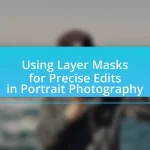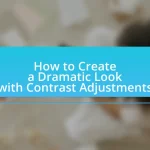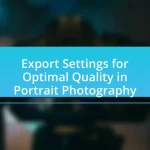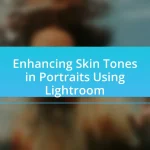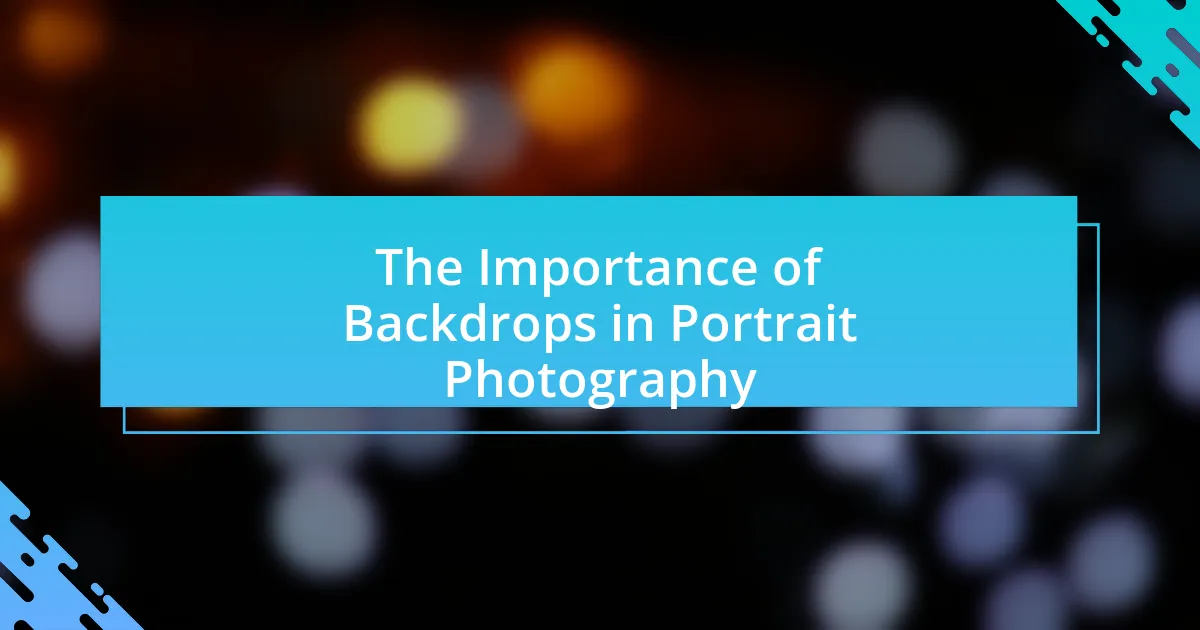The article focuses on the best lighting modifiers for portrait sessions, detailing essential tools such as softboxes, umbrellas, reflectors, and grids that alter light quality, direction, and intensity. It explains how these modifiers impact the aesthetic and emotional tone of portraits, enhancing subjects’ features and creating desired moods. The article also covers the various types of modifiers, their specific functions, and best practices for their effective use in photography, emphasizing the importance of selecting the right modifier based on the subject’s skin tone and shooting environment. Additionally, it provides insights into experimenting with modifiers and incorporating feedback to improve lighting setups for optimal results in portrait photography.

What are Lighting Modifiers for Portrait Sessions?
Lighting modifiers for portrait sessions are tools used to alter the quality, direction, and intensity of light in photography. These modifiers include softboxes, umbrellas, reflectors, and grids, each designed to create specific lighting effects that enhance the subject’s appearance. For instance, softboxes diffuse light, producing a soft and even illumination that reduces harsh shadows, while reflectors bounce light back onto the subject, filling in shadows and adding highlights. The use of these modifiers is essential in achieving professional-looking portraits, as they allow photographers to control the lighting environment effectively.
How do lighting modifiers impact portrait photography?
Lighting modifiers significantly influence portrait photography by altering the quality, direction, and intensity of light. These modifiers, such as softboxes, umbrellas, and reflectors, can soften harsh light, reduce shadows, and create a more flattering appearance on the subject’s skin. For instance, softboxes diffuse light, resulting in a softer, more even illumination that minimizes blemishes and enhances facial features. Research indicates that using soft lighting can improve the perceived attractiveness of subjects in photographs, as it creates a more natural and appealing look. Therefore, the choice of lighting modifier directly affects the overall aesthetic and emotional impact of portrait images.
What are the different types of lighting modifiers available?
The different types of lighting modifiers available include softboxes, umbrellas, reflectors, grids, and beauty dishes. Softboxes diffuse light, creating a soft and even illumination, while umbrellas can either reflect or diffuse light depending on their design. Reflectors bounce light to fill shadows and enhance highlights, and grids control the direction of light, allowing for more focused illumination. Beauty dishes provide a unique light quality that is flattering for portraits, combining the effects of both soft and hard light. Each modifier serves a specific purpose in shaping and controlling light for portrait photography.
How do lighting modifiers affect the mood and tone of portraits?
Lighting modifiers significantly influence the mood and tone of portraits by altering the quality, direction, and intensity of light. For instance, softboxes diffuse light, creating a gentle and flattering effect that enhances skin tones and evokes a calm atmosphere, while harsh light from reflectors can produce dramatic shadows, adding intensity and tension to the image. Research indicates that the use of different lighting modifiers can lead to varied emotional responses; for example, a study published in the Journal of Visual Communication in Medicine found that softer lighting is often perceived as more inviting and comforting, while harsher lighting can evoke feelings of unease. Thus, the choice of lighting modifier directly impacts the viewer’s emotional interpretation of the portrait.
Why are lighting modifiers essential for portrait sessions?
Lighting modifiers are essential for portrait sessions because they control the quality and direction of light, enhancing the subject’s features and creating a desired mood. By diffusing or reflecting light, modifiers reduce harsh shadows and prevent overexposure, resulting in more flattering images. For instance, softboxes create soft, even lighting that minimizes blemishes, while reflectors can fill in shadows, ensuring the subject’s face is well-lit. Studies in photography emphasize that proper lighting techniques significantly improve the aesthetic quality of portraits, making modifiers a crucial tool for photographers aiming for professional results.
What advantages do lighting modifiers provide to photographers?
Lighting modifiers provide photographers with enhanced control over light quality and direction, allowing for more creative and precise image outcomes. These modifiers can soften harsh light, reduce shadows, and create a more flattering illumination on subjects, which is particularly beneficial in portrait photography. For instance, softboxes diffuse light, resulting in a softer, more even spread that minimizes skin imperfections. Additionally, reflectors can redirect light to fill in shadows, improving overall exposure and detail. The use of these tools is supported by the fact that professional photographers often achieve higher-quality results by manipulating light effectively, as evidenced by numerous studies highlighting the impact of lighting on visual aesthetics in photography.
How do lighting modifiers enhance the subject’s features?
Lighting modifiers enhance a subject’s features by controlling the quality, direction, and intensity of light, which can create flattering shadows and highlights. For instance, softboxes diffuse light, reducing harsh shadows and providing a more even illumination that accentuates facial contours. Reflectors bounce light back onto the subject, filling in shadows and enhancing details, while umbrellas can spread light more broadly, softening its impact. Research indicates that proper lighting techniques can significantly improve the perception of beauty in portrait photography, as demonstrated in studies on visual aesthetics and lighting effects.
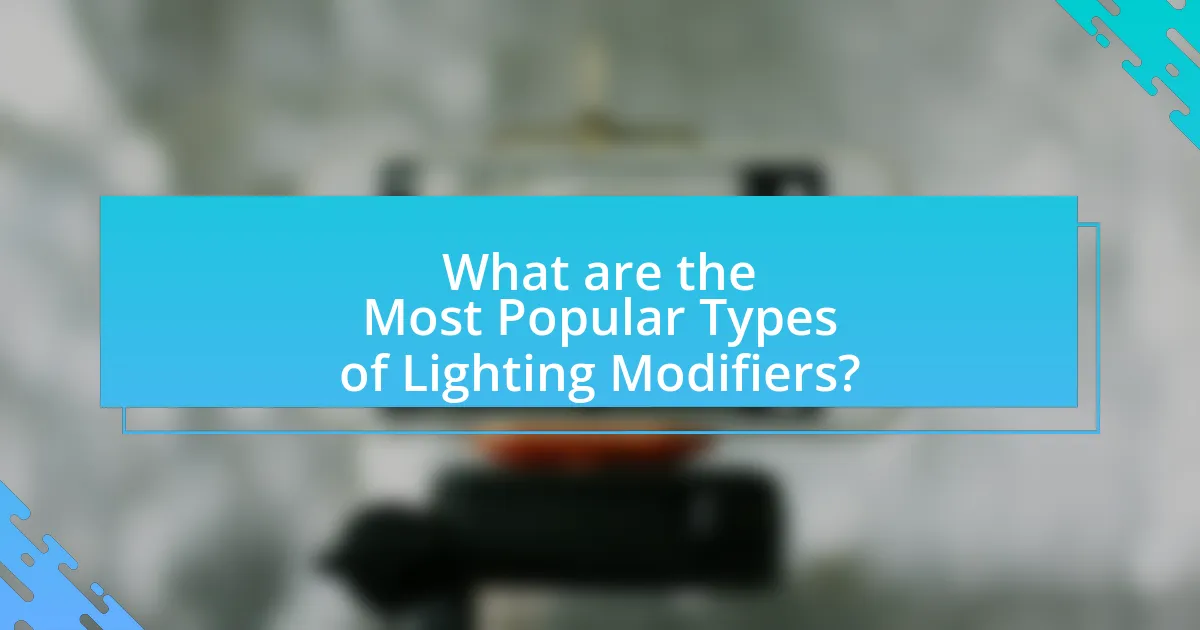
What are the Most Popular Types of Lighting Modifiers?
The most popular types of lighting modifiers include softboxes, umbrellas, and reflectors. Softboxes diffuse light, creating a soft and even illumination that is ideal for portrait photography. Umbrellas, which can be reflective or translucent, are versatile and portable, allowing photographers to achieve various lighting effects. Reflectors bounce light back onto the subject, enhancing highlights and reducing shadows, making them essential for achieving balanced lighting in portraits. These modifiers are widely used due to their effectiveness in controlling light quality and direction, which is crucial for flattering portrait sessions.
What are softboxes and how do they work?
Softboxes are lighting modifiers used in photography to diffuse light, creating a softer and more even illumination. They consist of a box-like structure with a reflective interior and a translucent front panel, which helps to spread the light emitted from a bulb inside. When light passes through the softbox’s diffusion material, it reduces harsh shadows and highlights, resulting in a more flattering light quality that is ideal for portrait sessions. This effect is particularly beneficial in portrait photography, as it enhances skin tones and minimizes imperfections, making subjects appear more appealing.
What sizes and shapes of softboxes are available for portrait sessions?
Softboxes available for portrait sessions come in various sizes and shapes, including rectangular, square, octagonal, and strip softboxes. Rectangular softboxes typically range from 24×36 inches to 48×72 inches, providing versatility for different lighting setups. Square softboxes, often sized around 24×24 inches or 36×36 inches, offer even light distribution, ideal for headshots. Octagonal softboxes, usually 36 inches to 60 inches in diameter, create a natural catchlight in the eyes, enhancing portrait aesthetics. Strip softboxes, which are long and narrow, generally measure 10×36 inches or 12×48 inches, allowing for precise lighting on subjects. These dimensions and shapes cater to various portrait styles and lighting needs, making softboxes essential tools for photographers.
How do softboxes compare to other lighting modifiers?
Softboxes provide a softer, more diffused light compared to other lighting modifiers such as umbrellas or reflectors. This diffusion results in reduced harsh shadows and a more flattering light quality, which is particularly beneficial for portrait photography. For instance, softboxes typically have a built-in diffusion layer that spreads light evenly, while umbrellas can create a more specular light that may not be as soft. Additionally, softboxes often allow for better control over light direction and spill, making them more versatile in various shooting environments. Studies in photography lighting techniques have shown that the quality of light significantly impacts the aesthetic appeal of portraits, reinforcing the preference for softboxes in professional settings.
What role do umbrellas play in portrait lighting?
Umbrellas serve as essential lighting modifiers in portrait photography by diffusing and softening light, which reduces harsh shadows and creates a more flattering appearance on the subject’s skin. The design of umbrellas allows them to either reflect or transmit light, depending on whether they are shoot-through or reflective types. Shoot-through umbrellas soften the light by allowing it to pass through the fabric, while reflective umbrellas bounce light off their inner surface, enhancing brightness and contrast. This versatility makes umbrellas a popular choice among photographers for achieving a balanced and aesthetically pleasing illumination in portrait sessions.
What are the different types of umbrellas used in photography?
The different types of umbrellas used in photography include reflective umbrellas and shoot-through umbrellas. Reflective umbrellas are designed to bounce light back onto the subject, creating a softer and more diffused light effect, while shoot-through umbrellas allow light to pass through the fabric, resulting in a more direct and softer illumination. These umbrellas are commonly used in portrait photography to control lighting and enhance the quality of the images.
How do umbrellas affect light diffusion and direction?
Umbrellas significantly affect light diffusion and direction by softening and spreading light, creating a more even illumination. When light passes through or reflects off an umbrella’s surface, it scatters, reducing harsh shadows and producing a flattering, diffused effect ideal for portrait photography. The angle and distance of the umbrella from the subject also influence the light’s direction, allowing photographers to control the intensity and spread of light effectively. This capability is supported by the principles of light behavior, where diffusion occurs as light interacts with various surfaces, leading to softer transitions between light and shadow.
What are reflectors and how can they be used effectively?
Reflectors are tools used in photography to redirect light onto a subject, enhancing illumination and reducing shadows. They can be used effectively by positioning them at angles that bounce natural or artificial light onto the subject’s face, creating a more flattering and evenly lit appearance. For instance, using a white reflector can soften harsh sunlight, while a silver reflector can increase brightness and contrast. Studies show that proper use of reflectors can significantly improve the quality of portrait photography by providing balanced lighting, which is essential for capturing details and textures in the subject’s features.
What materials are reflectors made from and how do they differ?
Reflectors are primarily made from materials such as silver, gold, white, black, and translucent fabrics. Each material serves a different purpose in modifying light; for instance, silver reflectors produce a bright, cool light, while gold reflectors create a warm, golden tone. White reflectors provide a soft, neutral bounce, and black reflectors absorb light, reducing reflections. Translucent materials diffuse light, softening shadows. The differences in these materials affect the quality and color of light, making them suitable for various portrait photography needs.
How can reflectors be positioned for optimal results?
Reflectors can be positioned for optimal results by placing them at a 45-degree angle to the subject and slightly above eye level. This positioning allows the reflector to bounce light onto the subject’s face, reducing shadows and creating a more flattering illumination. Studies in portrait photography indicate that this angle enhances the catchlights in the eyes and provides a natural-looking fill light, improving the overall quality of the image.
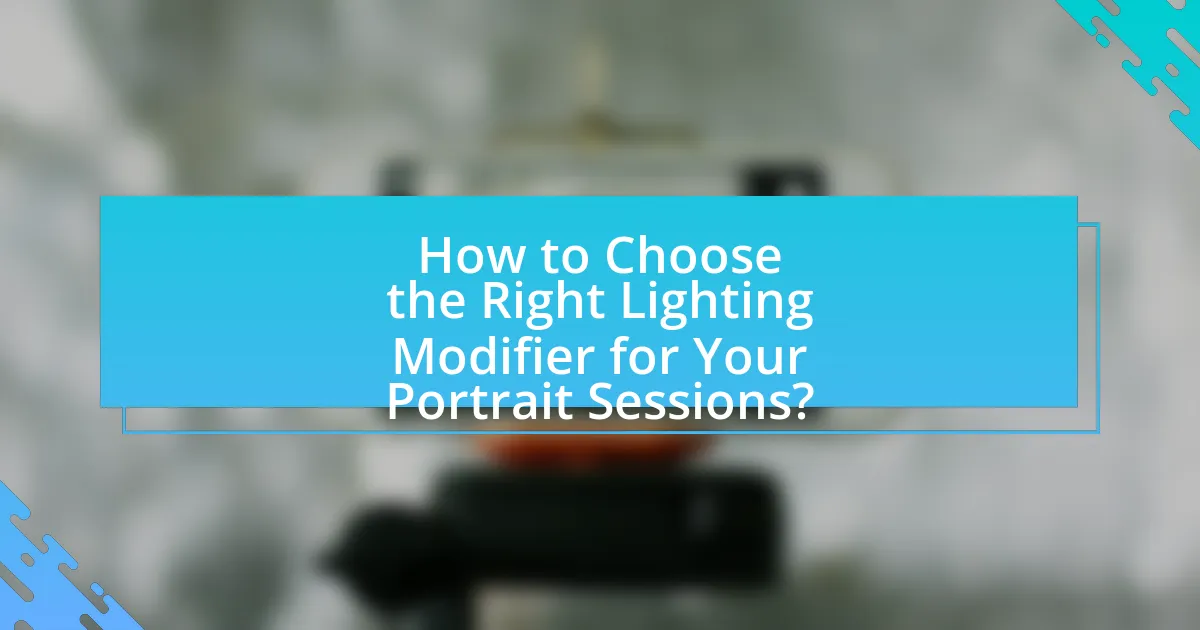
How to Choose the Right Lighting Modifier for Your Portrait Sessions?
To choose the right lighting modifier for portrait sessions, consider the desired effect on the subject’s features and the overall mood of the image. Softboxes create diffused light that minimizes shadows, making them ideal for flattering portraits, while umbrellas offer versatility and portability, providing either soft or hard light depending on their orientation. Additionally, beauty dishes produce a focused, soft light that enhances facial contours, making them popular for beauty and fashion photography. The choice should align with the specific look you aim to achieve, as each modifier influences the light’s quality and direction, ultimately affecting the portrait’s outcome.
What factors should be considered when selecting a lighting modifier?
When selecting a lighting modifier, key factors include the desired light quality, the size of the modifier, and the type of light source being used. The desired light quality determines whether a soft or hard light is needed, influencing the choice between diffusers, softboxes, or reflectors. The size of the modifier affects the spread and softness of the light; larger modifiers create softer light, while smaller ones produce harder light. Additionally, the type of light source, such as continuous or flash, impacts compatibility with specific modifiers, ensuring optimal performance and desired effects in portrait sessions.
How does the shooting environment influence your choice of modifier?
The shooting environment significantly influences the choice of lighting modifier by determining the quality and direction of light needed for optimal portrait results. For instance, in bright outdoor settings, a diffuser may be selected to soften harsh sunlight, while in low-light indoor environments, a reflector could be used to bounce available light and enhance subject illumination. Research indicates that modifiers can alter light intensity and texture, which is crucial for achieving desired aesthetic effects in varying conditions. Therefore, understanding the specific characteristics of the shooting environment directly informs the selection of appropriate modifiers to achieve the best portrait outcomes.
What is the importance of the subject’s skin tone in modifier selection?
The subject’s skin tone is crucial in modifier selection because it directly influences how light interacts with the skin, affecting the overall appearance in portrait photography. Different skin tones reflect and absorb light differently; for instance, lighter skin tones may require softer, diffused light to avoid harsh shadows, while darker skin tones can benefit from more contrast to enhance depth. Research indicates that using the appropriate lighting modifier can enhance skin tone representation, as demonstrated in studies showing that specific modifiers, like softboxes or reflectors, can create flattering highlights and reduce unwanted glare. Thus, understanding the subject’s skin tone allows photographers to choose modifiers that optimize the visual outcome in portrait sessions.
How can you experiment with different lighting modifiers?
To experiment with different lighting modifiers, photographers should systematically test various types such as softboxes, umbrellas, and reflectors in controlled environments. By adjusting the distance, angle, and intensity of each modifier, one can observe the resulting changes in light quality and shadow patterns. For instance, using a softbox at varying distances can demonstrate how light diffusion affects skin texture in portraits. This method allows for a practical understanding of each modifier’s impact on the final image, enabling photographers to make informed choices based on visual outcomes.
What techniques can be used to test the effectiveness of various modifiers?
To test the effectiveness of various lighting modifiers, photographers can employ techniques such as comparative analysis, controlled experiments, and subjective assessments. Comparative analysis involves taking side-by-side photographs using different modifiers under identical lighting conditions to visually evaluate differences in light quality, shadow softness, and overall aesthetic. Controlled experiments can be conducted by manipulating one variable at a time, such as distance from the subject or angle of the modifier, while keeping other factors constant to isolate the impact of each modifier. Subjective assessments involve gathering feedback from models or viewers regarding their preferences for images taken with different modifiers, providing qualitative data on perceived effectiveness. These techniques collectively enable photographers to determine which modifiers yield the best results for portrait sessions.
How can feedback from subjects improve your modifier choices?
Feedback from subjects can significantly enhance modifier choices by providing insights into their preferences and comfort levels during portrait sessions. When subjects express their thoughts on lighting effects, such as brightness or softness, photographers can adjust modifiers accordingly to achieve desired outcomes. For instance, if a subject indicates that harsh shadows are unflattering, a photographer might opt for a softer modifier like a softbox instead of a reflector. This adjustment is supported by studies showing that subjects’ perceptions of their appearance can influence their overall satisfaction with the portrait, thereby validating the importance of incorporating their feedback into the decision-making process for lighting modifiers.
What are some best practices for using lighting modifiers in portrait sessions?
Using lighting modifiers effectively in portrait sessions involves several best practices. First, choose the right modifier for the desired effect; softboxes create soft, diffused light, while reflectors can enhance natural light. Second, position the modifier at an appropriate distance from the subject to control the light’s intensity and quality; closer modifiers produce softer light, while those further away yield harsher shadows. Third, consider the angle of the light; placing the modifier at a 45-degree angle to the subject often results in flattering highlights and shadows. Additionally, experiment with different modifiers to understand their unique effects on skin tones and textures, as each modifier can dramatically alter the final image. These practices are supported by the fact that professional photographers consistently report improved results when strategically using modifiers tailored to their specific lighting needs.
How can you avoid common mistakes when using lighting modifiers?
To avoid common mistakes when using lighting modifiers, photographers should ensure they understand the characteristics and effects of each modifier before use. Familiarity with modifiers like softboxes, umbrellas, and reflectors allows for better control over light quality and direction, reducing the likelihood of overexposure or harsh shadows. Additionally, testing different positions and distances of modifiers from the subject can help achieve the desired lighting effect, as the distance significantly influences light intensity and softness. Properly adjusting camera settings in conjunction with the chosen modifier is crucial; for instance, using a lower ISO or adjusting shutter speed can prevent blown highlights. Understanding these principles is supported by the fact that many photographers report improved results after experimenting with various setups, highlighting the importance of practice and knowledge in mastering lighting modifiers.
What tips can help maximize the effectiveness of your lighting setup?
To maximize the effectiveness of your lighting setup, ensure proper placement and use of modifiers. Position lights at angles that create flattering shadows and highlights on the subject’s face, enhancing depth and dimension. Utilizing softboxes or diffusers can soften harsh light, reducing shadows and creating a more even illumination. Additionally, adjusting the color temperature of your lights to match the ambient light can prevent color casts and maintain skin tone accuracy. Research indicates that using a three-point lighting setup—key light, fill light, and backlight—can significantly improve the overall quality of portrait photography by providing balanced lighting and reducing unwanted shadows.

